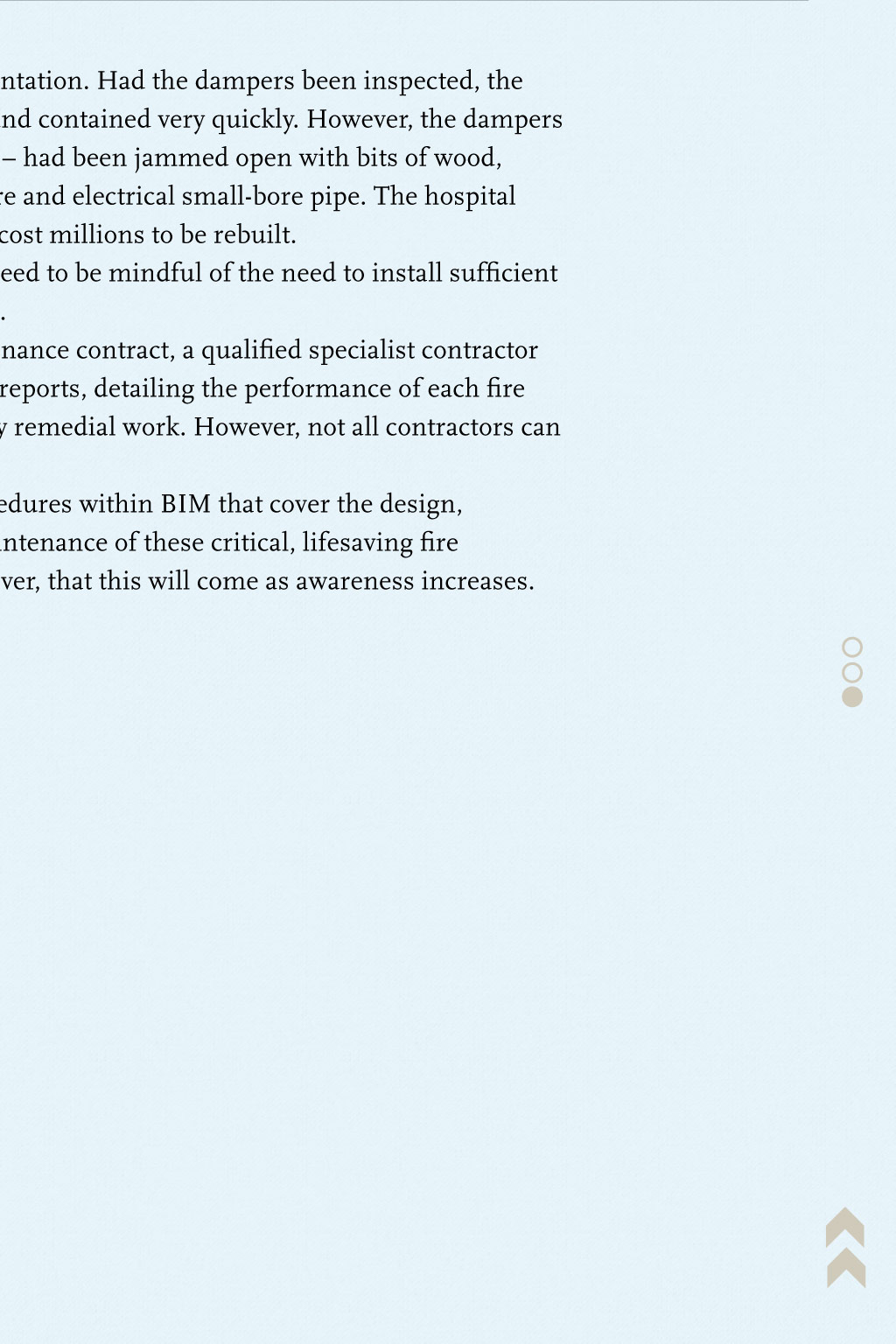












Opinion: Quinn Fanning the Flames Failure to manage fire-damper testing and maintenance can have serious consequences for those responsible for property management, says Dermott Quinn of Ductbusters Dermott Quinn is managing director of Ductbusters Fire dampers have been installed in ventilation ductwork systems in their thousands over the years. However, neither installers nor dampers were subject to inspection or a handover process, and consultants, architects and/or caretakers may not have been conversant with their installation or repair. They may have known they were there for fire purposes, but not how they functioned. It was and still is common for dampers to be installed the wrong way round and upside down. In addition, during installation and maintenance, linkages and/or dampers frequently collapse in a jammed-open position. If a problem occurs typically, loss of airflow the fitter or maintenance man will cure the problem. The correct procedure would be to inspect the damper, discover the fault and, usually, replace the fusible link or cassette. However, the easy way is to jam open the blade with a bit of wood or electricians wire, which obviously defeats the use as a fire damper. Regular inspection and drop testing of fire dampers is, therefore, essential. Regulations Fire Damper Regulations BS9999 state that fire dampers should be tested by a competent person at regular intervals not exceeding two years. Spring-operated fire dampers should be tested annually, and fire dampers situated in dust-laden or similar atmospheres should be tested much more frequently that this. In addition, periodic maintenance of any smoke-detector system used to Jammed fire damper It is not unusual to find a damper that has obviously never been inspected or tested because there is no access door installed operate fire dampers is required, to determine whether detection occurs at the appropriate design smoke density. For healthcare establishments, HTM 03-01 Part B stipulates annual maintenance of all ventilation plant. However, Channel 4 News recently reported that between March and June 2010, 418 fire dampers at Birminghams Queen Elizabeth Hospital were inspected and only 218 passed. Three were damaged and 197 could not be accessed. In 2011, 31 dampers were tested and only one passed. The biggest obstacle to fire-damper maintenance is lack of access, with many other services competing for space in ceiling voids, and small access doors that only offer access for inspection, not testing. To check and inspect a fire damper, we require the biggest access the ductwork will allow. We also require the area adjacent to the damper to be free from restrictions or other services. Lastly, we expect to see an access door adjacent to the fire damper it is not unusual to find a damper that has obviously never been inspected or tested because there is no access door installed! The Channel 4 programme revealed that a technical report issued shortly before the hospital opened included pictures of a damper sealed with tape, one propped open with a piece of metal and others built into the wall so they couldnt be accessed for testing. These problems are all too common. We have seen numerous instances of: damaged/jammed fire dampers; collapsed blades; corroded or jammed springs; dampers held open with wood; and dampers incorrectly installed upside down. We have also seen the damage caused by a lack of inspection and maintenance. At a leisure centre in the south of England where the smoke and fire dampers had been isolated and jammed, leaving them inoperable some discarded towels in a changing room combusted, producing a small fire with localised heat and extreme smoke. The smoke was drawn through the ductwork into the main plantroom and was then picked up by the recirculation ductwork system and distributed through the whole of the leisure centre. The cost to repair and cleanse all the smoke-affected areas ran into millions. Another blaze occurred in a large hospital where the dampers were installed in firewalls to allow compartmentation. Had the dampers been inspected, the fire would have been localised and contained very quickly. However, the dampers on both sides of the fire walls had been jammed open with bits of wood, hammer stales, electricians wire and electrical small-bore pipe. The hospital department and adjacent areas cost millions to be rebuilt. Developers and contractors need to be mindful of the need to install sufficient dampers with access for testing. As part of an ongoing maintenance contract, a qualified specialist contractor should provide comprehensive reports, detailing the performance of each fire damper and recommending any remedial work. However, not all contractors can carry this out. We are not aware of any procedures within BIM that cover the design, installation, inspection and maintenance of these critical, lifesaving fire dampers. We are hopeful, however, that this will come as awareness increases. "